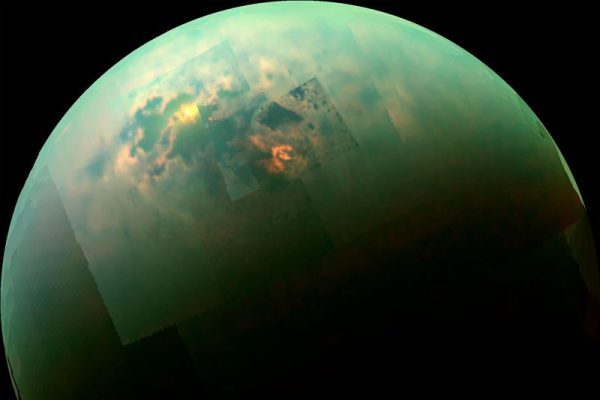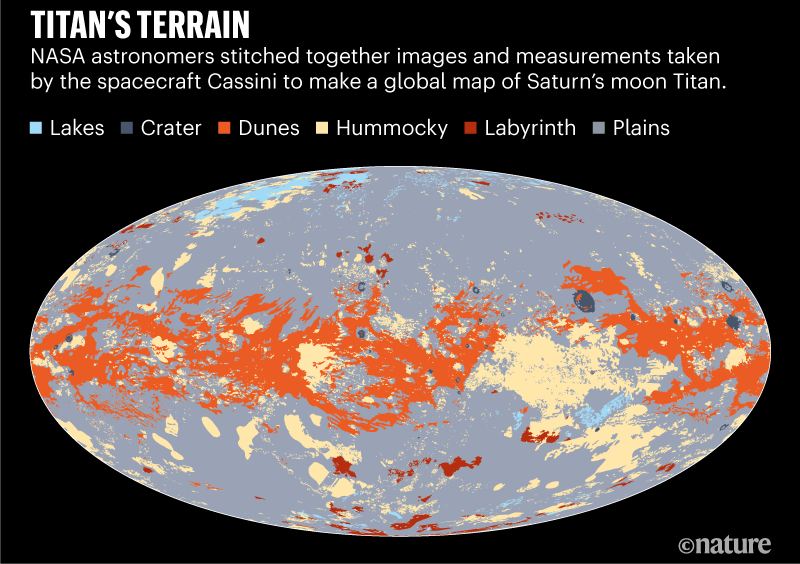A whole new world: astronomers draw first global map of Titan – Nature.com
Astronomers have used data from NASA’s Cassini mission to map the entire surface of Titan, Saturn’s largest moon, for the first time. Their charts reveal a diverse terrain of mountains, plains, valleys, craters and lakes unlike anywhere in the Solar System outside Earth.
The Cassini spacecraft orbited Saturn from 2004 to 2017 and collected vast amounts of information about the gas giant and its moons. The mission included more than 100 fly-bys of Titan, allowing researchers to glimpse the moon’s surface through its thick atmosphere and survey its terrain in unprecedented detail.
Rosaly Lopes, a planetary scientist at NASA’s Jet Propulsion Laboratory in Pasadena, California, and her colleagues stitched together images and radar measurements taken by the spacecraft to produce the first global map of Titan (see ‘Titan’s terrain’), which they published on 18 November in Nature Astronomy1.
“Titan has an atmosphere like Earth. It has wind, it has rain, it has mountains. It’s a really very interesting world, and one of the best places in the Solar System to look for life,” says Lopes.
Nearly two-thirds of Titan’s surface consists of flat plains, the map reveals, and 17% is covered in sandy dunes shaped by the wind, mostly around the equator. Around 14% of the surface is classified as ‘hummocky’ — hilly or mountainous — and 1.5% is ‘labyrinth’ terrain, with valleys carved by rain and erosion. There are surprisingly few impact craters, suggesting that the moon’s surface is fairly young.
Titan is the only world in the Solar System aside from Earth with known bodies of liquid on its surface. However, these seas and lakes are filled with liquid methane rather than water, and they cover just 1.5% of the moon’s surface.
“The most profound discovery of Cassini is that Titan is so diverse,” says Ralph Lorenz, a planetary scientist at the Johns Hopkins University Applied Physics Laboratory in Laurel, Maryland. “It’s almost like a completely different world, and this systematic mapping marshals that diversity.”
Astronomers have produced geological maps for a variety of other moons and planets, including our Moon, Mars and Mercury. Tracy Gregg, a planetary geologist at the University at Buffalo in New York, says that this kind of mapping is “an incredibly powerful tool” that will allow scientists to answer key questions about Titan. “One is: what kinds of changes has Titan gone through that are seasonal, and what sort of changes might be driven by the internal [heat] of Titan?” she says.
For example, most of the moon’s lakes are near its north pole, and scientists think that this is because Saturn’s elliptical orbit around the Sun causes Titan’s northern hemisphere to experience a longer summer — the season when rain falls and liquid accumulates on the ground — than does its southern hemisphere.
NASA plans to send a drone to Titan on the Dragonfly mission by 2034, which will fly across the surface and study it in multiple locations. But there are no current plans to send further orbiters to Saturn or its moons, so this map is likely to remain our best global view of Titan for the foreseeable future.







